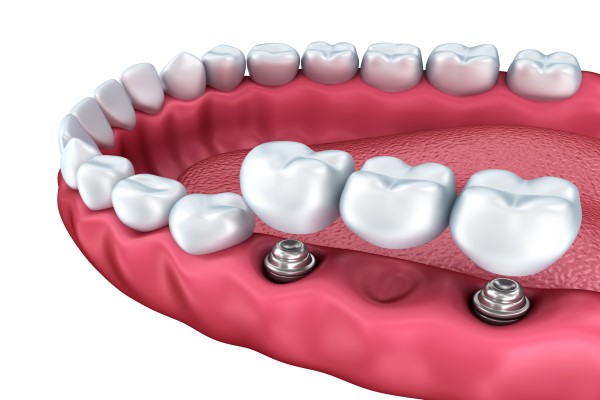How a Dental Bridge Can Replace a Missing Tooth

If you have had any teeth removed, you can replace them using dental bridges! In this guide, we will help you understand what they are and how they work. You can use this information to decide whether they are the right option for you.
What are they?
There are a few different kinds, but dental bridges most often comprise artificial teeth connected to crowns on both sides, which then cemented onto natural teeth. This allows the artificial teeth to be suspended without having to bind to any other components in your mouth.
Who is a candidate for them?
Dental bridges replace missing teeth, so you are a potential candidate if you have teeth missing. If you are in the advanced stages of tooth decay or your teeth are otherwise damaged beyond repair, you might need to get your teeth pulled, making you a candidate. However, you must have good enough oral hygiene that your bone structure and remaining teeth are strong and in good health. These teeth will be used to support the bridge, so if they are in bad shape, they will not last.
It is important to fill gaps in your smile, if possible, not only for your confidence but to increase your quality of life; otherwise, you may have difficulty chewing, and the increased stress on your mouth could cause pain.
What different options are there?
Four different options exist. Traditional bridges cement the crowns on the sides of the bridge to your natural teeth. The cantilever bridge is used when you want to preserve aesthetics, or some teeth cannot be used as supports; in this style, there are only crowns on one side of the artificial tooth. The Maryland bridge doesn't use crowns at all. It uses a metal framework and is most often utilized in children who are still growing. Lastly, implant-supported bridges offer the most stable solution but also the most expensive and invasive.
How does the procedure work?
The exact procedure will be different depending upon the bridge type you are getting, but it will generally start with an assessment and X-rays, during which time your dentist will decide which options are best for you.
At your first appointment, any teeth that need to support the bridge's crowns will be reshaped so that they can more easily do so. Then, impressions will be taken so that proper crowns and artificial teeth can be made. Alternatively, implants may need to be inserted if they are required for the bridge. Temporary bridges can be used between your first and second appointments.
At your second appointment, the temporary bridge will be removed, your teeth will be cleaned, and the crowns will be cemented to your teeth. Again, if dental implants are needed for your bridge, they will instead be attached to them.
After the bridge is inserted, you should practice good oral hygiene and get regular dental check-ups to preserve it for as long as possible. With proper care, it could last at least ten years.
Request an appointment here: https://www.smilesbyjulia.com or call Smiles By Julia at (954) 281-1231 for an appointment in our Fort Lauderdale office.
Check out what others are saying about our dental services on Yelp: Dental Bridges in Fort Lauderdale, FL.
Related Posts
Think you might need a dental bridge? Read on to learn more about this restoration. According to the National Institute of Craniofacial and Dental Research, adults aged 20–64 have an average of three decayed or missing teeth. A dental bridge is among the most important restorative dentistry procedures, helping to restore optimal dental health and…
A dental bridge, sometimes described as fixed partial dentures, is a type of dental restoration that replaces one or more missing teeth. Dental bridges are made of porcelain or other materials. The tooth or teeth on either side of the gap are prepared to receive crowns and false teeth (known as pontics). The false teeth…
Did you know that you can repair teeth gaps with a dental bridge? The purpose of a dental bridge is to replace missing teeth, which often leads to cosmetic, functional, and oral health concerns. Understanding the pros and cons of dental bridge treatment can help you decide whether it is right for you or if…
Dental bridges are effective at replacing missing teeth. However, having a bridge does not mean that you can neglect your oral hygiene. On the contrary, with a bridge, dental hygiene becomes even more important than before. However, you may have to learn new techniques for cleaning your dental bridge, as well as avoid some behaviors…
